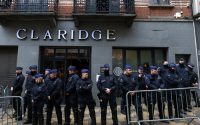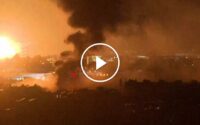Israeli Strike Kills Dozens at Civilian Shelter in Gaza
An Israeli airstrike on Thursday hit a United Nations school complex in central Gaza that had become a shelter for thousands of displaced Palestinians and, Israel said, Hamas militants. Gazan health officials said dozens of people were killed, including women and children.
The strike was the latest in a deadly surge of fighting in central Gaza, where Israeli forces have announced an offensive against what they describe as a renewed insurgency by Hamas.
Of the 40 people killed in the attack, 14 were children and nine were women, Gaza’s Health Ministry said, although the precise toll could not be independently verified. Crowds gathered at the Al-Aqsa Martyrs Hospital in the central Gaza city of Deir al Balah to weep and pray over the dead. A local Palestinian videographer posted footage showing a young woman with the body of her small son.
The strike hit a compound that had been operated by UNRWA, the main U.N. body that aids Palestinians in Gaza. About 6,000 displaced Palestinians were sheltering in the complex, located in the central Gaza area of Nuseirat, when the strike took place, said Juliette Touma, an UNRWA spokeswoman.
The Israeli military said its fighter jets had targeted three classrooms in the school building that held 20 to 30 Palestinian militants affiliated with Hamas and Palestinian Islamic Jihad, a smaller militia that, like Hamas, is backed by Iran. Israeli forces had twice postponed the strike to reduce civilian casualties, the military said.
Lt. Col. Peter Lerner, an Israeli military spokesman, said he was “not aware of any civilian casualties” resulting from the strike. “We conducted a precise strike against the terrorists where they were,” he said. He said the militants had used the compound to plan attacks on Israeli forces, although he did not provide specific examples.
Rear Adm. Daniel Hagari, another Israeli military spokesman, said Israeli forces had followed the militants for three days before opening fire.
“They pinpointed the three classrooms, waited three days and then killed,” he added.
Israeli security agencies have so far verified the identities of nine militants killed in the strike, “some” of whom participated in the Hamas-led Oct. 7 attacks, Admiral Hagari said.
“We are now busy with confirming the identities of the additional terrorists killed,” he said.
A State Department spokesman, Matthew Miller, said Israel had conveyed to the United States that it was targeting Hamas militants with precision weapons. But, he added, if reports that children were among those killed in the strike were accurate, “then those aren’t terrorists.” He said the United States expected Israel to be “fully transparent” in releasing more information.
A spokesman for the Al-Aqsa Martyrs Hospital, Khalil Daqran, said that at least 140 Palestinians had been killed and hundreds more wounded in recent days during the Israeli offensive in central Gaza, severely taxing the hospital’s already depleted resources.
“Wounded patients are lying on the ground in the hallways and in tents outside,” he said. “And our capability to treat them at this point is extremely limited.”
For hours early Thursday, one man, Haitham Abu Ammar combed through the rubble of the school. As dawn broke, he struggled to gather the body parts of a friend who had died in the blast.
“The most painful thing I have ever experienced was picking up those pieces of flesh with my hands,” said Mr. Abu Ammar, a 27-year-old construction worker. “I never thought I would have to do such a thing.”
In the crowded, chaotic hallways of the hospital — Gaza’s last functioning medical center — men cried over dead children while doctors had to push their way into operating rooms. One man, lying in his own blood, had fruitlessly been waiting hours for surgery, said a relative who accompanied him.
A reporter who visited the hospital’s morgue on Thursday experienced the overpowering stench of the scores of bodies, with loved ones screaming and crying over them.
Josep Borrell Fontelles, the European Union’s top diplomat, called for an independent investigation into the Israeli strike.
B’Tselem, a leading Israeli human rights group, said the Israeli attack on the school turned shelter could be a war crime. It said that if Hamas had indeed used the complex for military purposes, as claimed by the Israeli military, that would also be illegal. “But that could not justify massive harm to civilians who had fled there, terrified by the ongoing combat,” B’Tselem said in a statement.
At least one bomb used in the Israeli strike on the school building Thursday appeared to have been made in the United States, according to a weapons expert and videos reviewed by The New York Times. It was identified as a GBU-39, a relatively small, precision-guided bomb manufactured by Boeing Corp. that has become an increasingly important weapon as Israel has shifted to more limited and targeted attacks.
As the renewed Israeli offensive in central Gaza unfolded, cease-fire talks between Israel and Hamas remained stuck, with senior officials on both sides expressing deep concerns over a proposal endorsed by President Biden for a phased truce that would also see the release of hostages held in Gaza in exchange for Palestinian prisoners.
The Biden administration dispatched top officials this week to Egypt and Qatar, which have been mediating the talks. But Israeli officials including Prime Minister Benjamin Netanyahu have signaled they are not ready to wind down their eight-month war in Gaza, which has killed more than 36,000 people there, according to Palestinian health officials in the enclave.
At least 450 people have been killed while sheltering in schools and other facilities run by UNRWA since the beginning of the war, the agency says.
Israeli forces attacked the same compound that was struck Thursday in Nuseirat just three weeks ago, killing at least six people and wounding others, UNRWA said.
The number of people in central Gaza has swelled in recent weeks as Gazans fled an Israeli offensive in the southern city of Rafah, which had been the main refuge for civilians displaced by fighting elsewhere. With the offensive in Rafah, hundreds of thousands of Gazans are now crowding into temporary camps in the area where finding enough food and clean drinking water has become a daily struggle.
Before the war, UNRWA ran a boys’ school at the complex in Nuseirat. The agency says that it has shared the coordinates of all its facilities — including the one targeted on Thursday — with Israel and “other parties to the conflict” so that they would not be hit.
“Attacking, targeting or using U.N. buildings for military purposes are a blatant disregard of International Humanitarian law,” Philippe Lazzarini, the head of UNRWA, wrote on social media on Thursday. He called Israel’s accusations of militants’ using the complex “shocking,” but said the agency was unable to verify them.
In mid-April, UNRWA said in a report that the Israeli military had committed the majority of “attacks and actions” that had damaged or harmed the agency’s facilities, but that Palestinian armed groups had been responsible for some as well.
The United Nations’ human rights office said in a statement Thursday that it was shocked by the Israeli strike in Nuseirat, saying it “suggests a failure” by the Israeli military to “ensure strict compliance with international humanitarian law, particularly the basic principles of distinction, proportionality and precaution in attack.”
Reporting was contributed by Bilal Shbair, Nader Ibrahim, Christiaan Triebert, Anushka Patil, Rawan Sheikh Ahmad, Johnatan Reiss and Lauren Leatherby.


